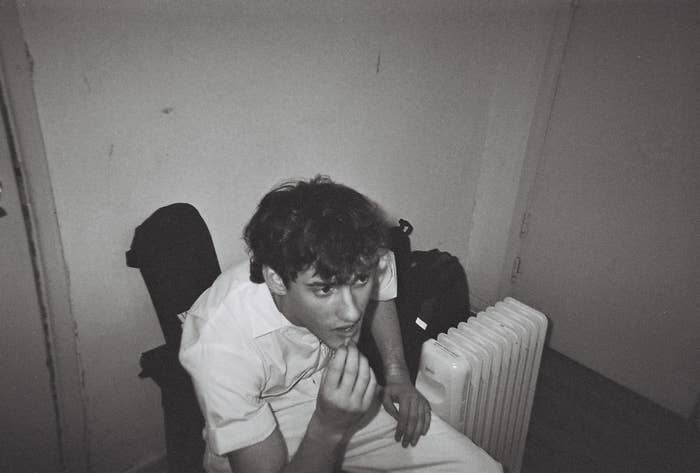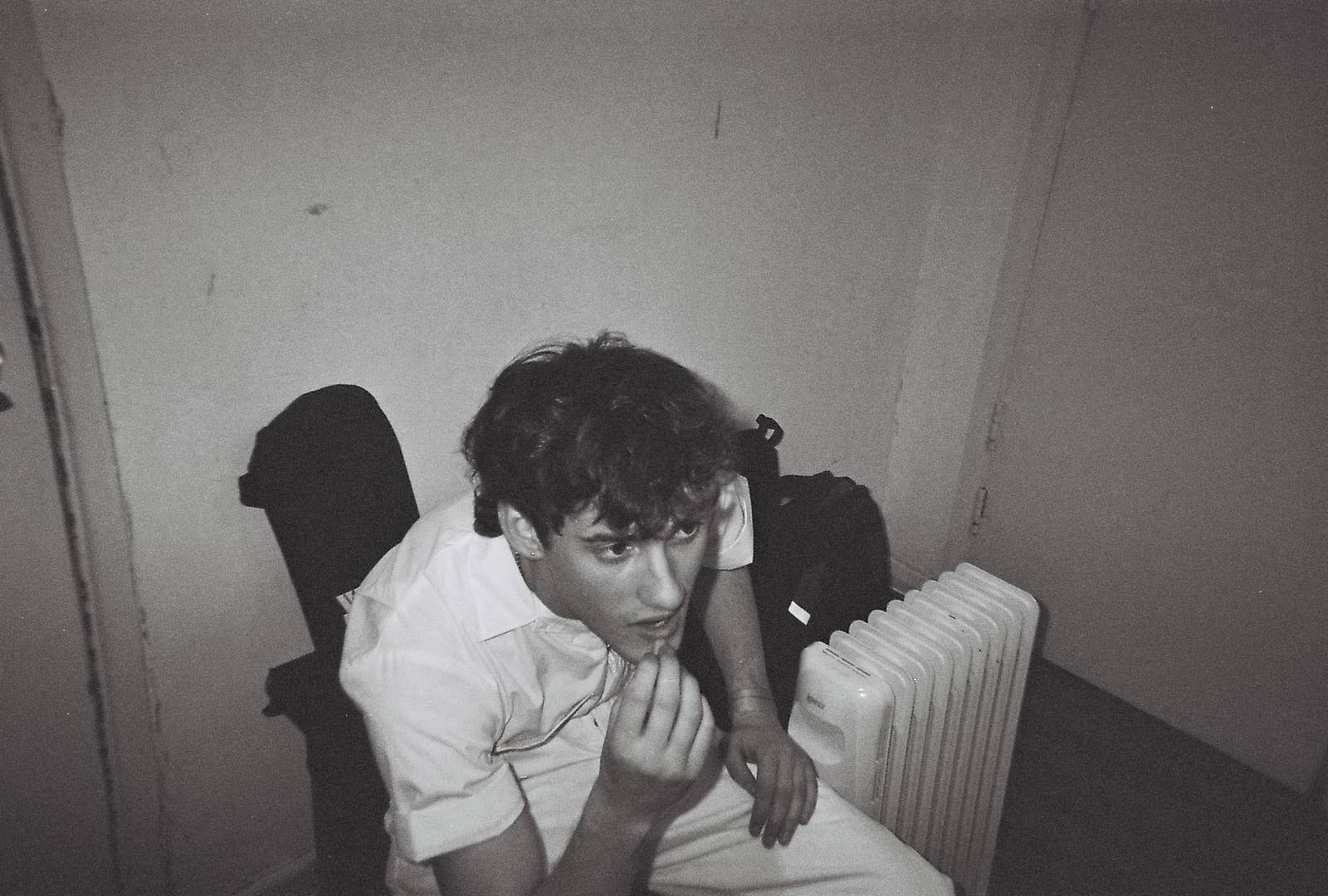
Charlie Burg is an artist raised in Detroit and currently living in Brooklyn. Having recently released a new single, “Channel Orange In Your Living Room,” Charlie wrote a few words about being an artist during a global pandemic, finding inspiration, and more.
I have a skylight in my bedroom so every morning, whether I like it or not, I awake to blinding sunlight. Last Wednesday, after waking up at 2pm, I turned to a blank page in my journal and wrote a list of people whom I haven’t called in a long time. It sat for four days before I looked at it again. A few nights ago, I fell asleep at 6 in the morning. For a week I was eating five club crackers for lunch and a bowl of canned vegetable soup for dinner. I would leave the apartment every few days for a cautious 30-minute walk around my Brooklyn neighborhood, wary of catching the exhale of a passerby. Only a global pandemic could have revealed my body’s capability for such an unsustainable routine.
Last Spring, with college in my wake and music my only compass, I set out for New York in search of belonging. It took many months to feel comfortable creatively again, as uprooting myself put a strain on my ability to emote. Just when I finally felt my heart returning to the rhythm of creativity, the world shut down. It’s been almost three weeks since I’ve been able to write with passion. Some artists find comfort in solitude. Being alone and having a certain tunnel-vision on their art is ideal for their productivity (given the ability to ignore the desolate state of the world for a little), and they see this as a time to focus and create. For others, this does not prove so fruitful. I myself am an artist whose process has always been fluid and fickle, never static. Nothing arrives to me in order, nothing in its fullest form. A flare of inspiration finds me rushing to whatever tools are immediately available to me to grab hold of a passing inkling that, in moments, will likely be gone forever.
It wasn’t until the last few months that I realized that the unpredictability of my process implies that inspiration is external, rather than inside of us. What does live inside of us is our story, our past, our ability to remember, to use what we’ve learned, to act with intention. These are what we have control over as creatives and as people living in a time of uncertainty. This realization allowed me to treat my creativity like a muscle—and muscles need exercise if they are to strengthen. Last autumn, I was reminded by a songwriter whom I admire with all my heart that it is dangerously easy to take a passive approach to creativity, and dismiss artistic dry spells as being out of one’s control. But once you understand the location of the spark (or the idea of “genius”) to be somewhere external, you can reset your approach and be ready to welcome inspiration when it comes. Sit down every day, write your worst work yet, accept it (thus accepting yourself), and let the next spark come when it will. They say you can’t choose when inspiration strikes; but what if you made its bed and drew it a bath for when it’s ready? Prepare your mind for creativity, and do what is in your power to beckon that elusive muse that escapes us all.
None
Habits can be wonderful. Habits can give you structure, meaning, motivation in your day. Some habits, however, slip under your radar as complacency. Here’s an example: listening to your favorite artists. It is natural to gravitate towards what you know you already like. But consider this: what can you learn from something you don’t understand? Plunge into an artist, an author, a culture, an artistic genre that you’ve always written off as “not your taste.” To challenge habits is to grow, and growth in itself can be art.
In the beginning my quarantine felt tolerable, even promising. I recognize my privilege as someone whose work, in many ways, doesn’t immediately suffer from the devastating impact of this pandemic. I also believe it’s important to note how lucky I am to be in decent enough health to live alone without much trouble. Acknowledging this as my situation, I turned inward, and found myself feeling somewhat optimistic at the prospect of a world-wide reset. Many others who are not so privileged weren’t at luxury to have such optimism. I saw an opportunity to learn new things about myself in isolation, to unlearn habits I’d developed as a response to living in a world that moves like an unstoppable machine.
After just a week of my quarantine, as the machine slowed, the prospect of positivity all but completely faded. Gloom set in, along with the realization that no one knows how long this will last. I thought to myself, How can I create—my creativity being my drive, my food, my purpose—while knowing of some silent, invisible threat that neither I nor the world can control? I paced, I stayed up until ungodly hours, I called friends multiple times throughout the day, allowing myself to sidestep my discomfort. Whatever solace I took from reminders that everyone is going through this quickly subsided.
A few nights ago, something changed. I saw the faces of my gorgeous family on a Passover Seder video chat and was instantly reminded of what matters. My father spoke. How lucky I am to be able to speak with my father. My sister laughed. How lucky I am to know her and call her my sister. I knew my habits needed alteration, and I reflected and willed myself to take hold of my present. And I knew it would start with being thankful.
If you are having trouble remembering what to be thankful for during this time, here are a few lighthearted suggestions. You are reading these words right now. You have access to a screen. You live on the same planet as Sade. You have art, you have music—we all do, because they exist and will always exist, no matter how isolated we are from each other. You couldn’t kill art if you tried. This thought of permanence encourages me to approach my own art differently.
These days I wake up, I buckle in, wave hello to the ever-elusive inspiration fairy wherever she may be, spout some ideas onto paper, and leave them alone. They are bad, and I accept them. I put judgement on the shelf. Then I give output a rest, and work on input. Five pages of Hamlet, three episodes of a new anime, one phone call to my beloved grandma (whom my siblings and I call Gaga), and a stroll around the perimeter of Maria Hernandez Park. I let my mind recall the story a taxi driver told me about this park last summer. I watch the dogs roll around in the grass. I listen to the sounds of skateboard wheels whirring over the cement in the park square. There is no end to beauty, however volatile beauty may be, and there are no rules for creativity. But if I had to make one rule, it would be to Learn From Your Present And Challenge Your Habits. This may sound difficult to do during quarantine, but that is precisely why we need to do it.
None
Did you know you never have to purchase another plant again? You can propagate the one you already have by carefully removing a healthy leaf from the plant and putting its stem in water. After a couple of weeks of close monitoring, it will begin to grow roots, and you can transfer it to a pot with soil where the plant will grow and thrive. You’ve been creative before, you’ve known the spark; you’ve had the realization that you yourself can be a conduit of beauty, of light. You, artist, can feel it again, replant yourself and thrive, with just a little fostering, attention and intention. I once read on the back of a soap bottle that there is a saying in gardening: if a plant doesn’t grow well, don’t blame the plant, try to understand why. Here is me giving you an excuse to allow yourself to lift blame, to make bad art.
To blame yourself for not making good art is to not believe that what you have to say is worthwhile. It’s time to take responsibility for what you have to say, so that you may take your place in the community of artists awaiting you. In her book Bird By Bird: Some Instructions on Writing and Life, Anne Lamott says, “The great writers keep writing about the cold dark place within, the water under a frozen lake or the secluded, camouflaged hole. The light they shine on this hole, this pit, helps us cut away or step around the brush and brambles.” Illuminating this darkness must be done as a community. We hold power to inspire each other, if we trust each other. This is our present, and we have no choice but to overcome together. In Lamott’s words, “We can dance around the rim of the abyss, holler into it, measure it, throw rocks in it, and still not fall in. It can no longer swallow us up. And we can get on with things.”

